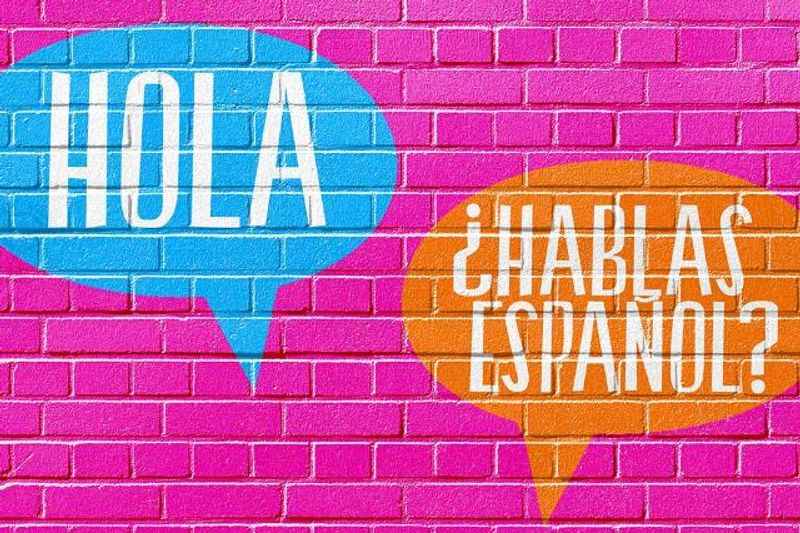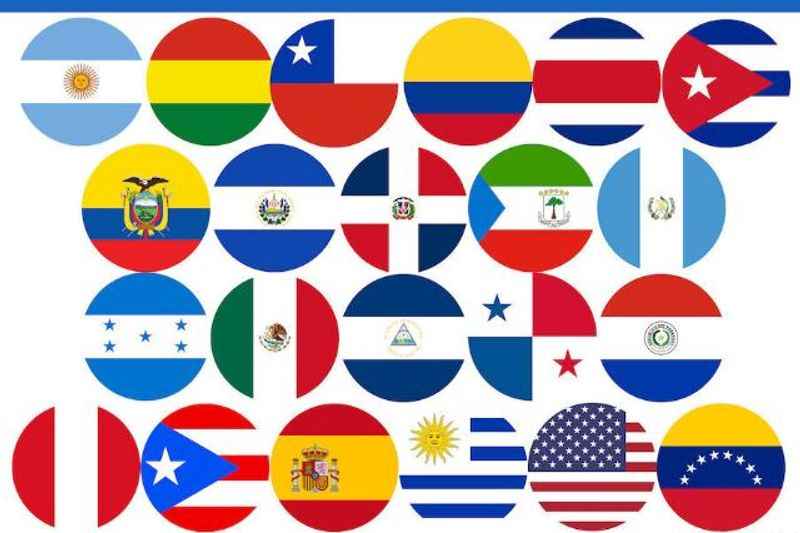11 Different Types of Spanish & Where They Are Spoken

The Spanish language is the second most spoken language in the world by native speakers, and it has more than 500 million speakers globally. So, it's no wonder that there are multiple types of Spanish across the globe.
These Spanish speakers, both native and non-native, are dispersed across every continent and, while they can all communicate with one another, they speak different types of Spanish.
Today, we will explore the variations of Spanish spoken in Spain and across other Spanish-speaking countries of the world.
By the end of this guide, you will have a deeper understanding of the differences between various European, African, and Latin American Spanish dialects.
The Spanish Language: A Brief Summary

Spanish is a Romance language belonging to the Indo-European language family that evolved from Vulgar Latin. It originated in Europe, but Spanish colonizers in the Early Modern Period introduced the language to the Americas and parts of Africa. Across these continents, there are many different types of Spanish.
Now, the largest population of native Spanish speakers is in Mexico. Spanish is spoken in different dialects around the world and it is the official language of 20 countries and 1 territory.
Spanning the continents of North, Central, and South America, as well as Europe and Africa, Spanish speakers are spread far and wide.
It is the third most used language on Internet sites, after English and Chinese. So, by learning Spanish, you become part of a vast and diverse community.
Types of European Spanish

In Europe, the varieties of the Spanish language are known collectively as "Spain Spanish", or Peninsular Spanish (of the Iberian Peninsula). There are different Spanish dialects across Spain, some of which are considered by their speakers to be languages in their own right.
If you Speak one form of European Spanish, you will be able to communicate with all other European Spanish speakers, though the regional variations do boast some distinctive differences.
1. Castilian Spanish
Known en Español as Castellano, Castilian Spanish is spoken across Spain, particularly in the northern and central parts of the country.
Sometimes Castilian is referred to as "pure" Spanish, however, the idea of "pure" languages is controversial, as all dialects have a rich history and should not be seen as lesser.
If you learn Spanish in school, you will learn this version of the language. One distinctive feature of Castilian Spanish is that when a word ends in /d/, it may be pronounced as a soft sound between a "d" and "th", represented phonetically as ⟨θ⟩.
Castilian Spanish differs from other official languages in Spain, such as Catalan, Catalan dialects, Basque and Galician.
2. Andalusian Spanish
Variants of the Andalusian dialect are spoken across Southern Spain. They differ from central and northern Spanish dialects in their pronunciation and lexicon in several ways.
Historically, the rest of Spain looked down on these dialects, however, this is gradually becoming less prevalent. Within Spain today there are many different types of Spanish.
Andalusian Spanish is sometimes referred to as a language in its own right by its speakers and is known to be difficult for Spanish learners to understand at times, due to the dropping of letters in words.
When a "d" occurs between two vowels, such as in the word pesado ("heavy"), it is often dropped. So, an Andalusian would say pesao. Other examples of this are a menúo for a menudo ("often") and he ganao for he ganado("I have won").
3. Canarian Spanish
The Canarian dialect is similar to Caribbean and Andalusian Spanish because of the location of the Canary Islands. It is influenced by Iberian Spanish, Arabic, and the Guanche native language.
Guagua is the local word for "bus", rather than autobús, and alacránis "scorpion", rather than escorpión.
4. Llanito
Spoken in Gibraltar, Llanito is a combination of Andalusian Spanish and British English. This is because Gibraltar is a British overseas territory off the South coast of Spain. It is also heavily influenced by Genoese, Hebrew, Maltese, and Portuguese.
The Spanish Lisp
The famous Spanish lisp is sometimes referred to as the "Castilian lisp", however, this phenomenon is not only heard in Castilian Spanish. In most Spanish dialects across Spain, the distinction (distinción) between the "s" (s) and "th" (c) sounds is realized.
In central Spain, particularly Madrid, and surrounding areas, the "th" sound is very prominent.
Only in parts of southern Spain do they pronounce both s and c as "s". This pronunciation is known as seseo, and it is standard across Latin America.
In the southernmost parts of Spain, some Andalusian Spanish speakers will pronounce both sounds as "th". This is known as ceceo.
North American Spanish

Next, let's jump across the pond and discuss Spanish in the Americas.
5. New Mexican Spanish
This is a variation of Spanish that is spoken in the state of New Mexico and in southern parts of Colorado.
There are some distinct conjugation changes in New Mexican Spanish. The conjugation of haber is: ha, has, ha, hamos, han. So, the present perfect tense looks like yo ha comido, for instance.
6. Mexican Spanish
Mexican-Spanish is different from Spain-Spanish variants, as it is influenced by the Indigenous languages Nahuatl and Tzotzil, as well as American English. The Mexican accent is distinct as it has a slightly nasal and drawn-out tone.
Some sayings common in Mexico include ¿qué onda? ("what's the vibe?/ what's up?) and ahorita ("right now" or, in Spanish/ Latin fashion "whenever I get around to it").
Other Types of Latin American Spanish

The large portion of the world known as Latin America includes all the countries and territories in North, Central, and South America that speak Latin languages, such as Spanish or Portuguese.
The broad term "Latin American Spanish" refers to all Spanish dialects and variations spoken in Mexico, Central America, and Spanish-speaking South American countries.
7. Central American Spanish
Spoken in Costa Rica, Guatemala, Panama, Nicaragua, Honduras, and El Salvador, "Central American Spanish" is another huge umbrella term for many dialects.
Speakers of Central American Spanish sometimes turn their "s" sounds into "h" sounds and can drop the "j" and "m" sounds entirely in certain words, such as ejercicio.
8. Caribbean Spanish
The Spanish spoken along the Caribbean coast of the Americas resembles Andalusian and Canarian Spanish in pronunciation. It is spoken in Cuba, the Dominican Republic, and Puerto Rico, as well as parts of Panama, Colombia, and Venezuela.
Caribbean Spanish notably uses the second person subject pronouns more than other Spanish variants, which often omit them when the meaning is clear. So, ¿Qué tú quieres? instead of ¿qué quieres? and tú estás hablando, rather than simply estás hablando.
9. Colombian Spanish
When we talk about "Colombian Spanish", we are referring to various Spanish dialects spoken across a huge geographic area. The diversity of populations, cultures, and histories in Colombia means that the Spanish forms vary greatly across the country.
Generally, when the /b/, /d/, and /ɡ/ sounds occur between vowels, they are very weak. So, Bogotá may be pronounced without the "g". Colombian Spanish is the Spanish you will often hear in modern Latin American music.
10. Rioplatense Spanish
This dialect is spoken in the River Basin region between Argentina and Uruguay and is distinctive for its different verb conjugations and pronunciation.
Speakers of Rioplatense Spanish use voseo (vos) as the second person singular pronoun instead of tú, and they do not generally speak as fast as Chileans or Caribbeans.
In most Spanish dialects, the yeísmo pronunciation is standard. This means that "ll" and "y" are both pronounced like the "y" in the English word "your". So, calló and cayó would be pronounced like "ca-yo".
In Argentina, _zheísmo_is common. This is when the "ll" and "y" sounds are pronounced somewhere between a "sh" and a "j" sound.
The first Spanish speakers in Argentina spoke Andalusian Spanish, then after the Second World War, many Italians moved to Argentina, which could account for their distinctive pronunciation.
Word Choice
There are also many examples of words that have entirely different translations in European and Latin American Spanish.
"Juice" is zumo in Spain and jugo in Latin America, “glasses” in the Americas are lentes but in Spain are gafas, and "potatoes" are patatas in Europe but papas across the Atlantic.
African Spanish

Finally, there is Spanish spoken in Africa as well.
11. Equatoguinean Spanish
Spoken in Equatorial Guinea, this is the only Spanish dialect that holds official status in Sub-Saharan Africa. It has more similarities with European Spanish than American Spanish variants.
A distinct feature of this Spanish dialect is that the pronoun usted can be used with the tú verbal conjugation and vosotros can be used interchangeably with ustedes. Moreover, there is no distinction between the subjunctive and indicative moods.
FAQs About the Different Types of Spanish
Now, let's look at some frequently asked questions about Spanish dialects around the world.
Is it easier to learn Spanish-Spanish or Latin American Spanish?
Latin American Spanish is simpler in some ways, as it does not use the vosotros conjugation and is generally easier to pronounce, without the "Spanish lisp". However, there are quite distinct dialects in Latin America, in Argentina and the Caribbean, for instance. It depends on where you go.
Which country has the most Spanish speakers?
Mexico is the largest Spanish-speaking country, with over 120 million native speakers. Colombia also has a larger Spanish-speaking population than Spain itself, with 50 million natives. Spain is third, with 47 million natives, shortly followed by Argentina, which has 45 million.
Do I need to learn different Spanish dialects when I visit Spanish-speaking places?
No, you do not need to learn whole new dialects in Spanish in order to travel. All Spanish speakers can understand all other Spanish speakers. However, you can make an effort to use the correct local conjugations, terminologies, and pronunciations when visiting different countries.
Summing Up: Different Types of Spanish Around the World
Now that you have skimmed the surface of several different types of Spanish, you should have a better idea of the diversity and complexity of the Spanish language. It is full of nuances, different verb conjugations, and accents.
Every country and region has its own Spanish dialects, just like many other languages.
In this post, we have looked in some detail at the major Spanish dialects, focusing on differences in pronunciation, conjugation, and word choice.
These differences arise as a result of Spain's colonial past (just look up the Spanish Empire for context), and the Spanish-speaking populations mixing with indigenous American and other European communities.
There are other Spanish dialects and communities we have not discussed today. You can learn about their language through engagement with TV shows and movies set across el mundo hispanohablante.







